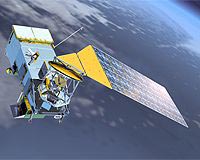 |
Bangalore, India (SPX) May 25, 2011 In the second orbit raising manoeuvre conducted at 12:22 hrs IST (May 23, 2011), the Liquid Apogee Motor (LAM) on board GSAT-8 was fired for 35.8 minutes by commanding the satellite from ISRO's Master Control Facility (MCF), Hassan. With this LAM firing, GSAT-8 perigee (closest point to earth) has been raised to 32,385 km. The apogee (farthest point to earth) height remains at 35,768 km. The inclination of the orbit with respect to the equatorial plane has been reduced to 0.06 deg. GSAT-8 now has an orbital period of 22 hours 29 minutes. The satellite will now be in the continuous radio visibility of MCF, Hassan. GSAT-8 was launched by the European Ariane-5 launch vehicle on May 21, 2011 from Kourou, French Guiana. The launch vehicle had placed GSAT-8 in an orbit with a perigee of 258 km and apogee of 35,861 km with an inclination of 2.5 deg with respect to the equatorial plane. With the first orbit raising manoeuvre carried out from MCF, Hassan yesterday (May 22, 2011), GSAT-8 had been put in an intermediate orbit of 15,786 km perigee and 35,768 km apogee and the orbital inclination was reduced to 0.5 degree with respect to the equatorial plane. The next orbit raising manoeuvre to place GSAT-8 in near Geosynchronous Orbit is planned on May 24, 2011. Deployment of the two solar panels and the two antennas will be carried out subsequently.
Share This Article With Planet Earth
Related Links ISRO Space Technology News - Applications and Research
 NASA's NPP Satellite Completes Thermal Vac Testing
NASA's NPP Satellite Completes Thermal Vac TestingGreenbelt MD (SPX) May 25, 2011 The NASA National Polar-orbiting Operational Environmental Satellite System (NPOESS) Preparatory Project (NPP) climate and weather satellite has successfully passed all environmental testing with the recent completion of thermal vacuum testing at Ball Aerospace and Technologies Corp's production and test facility in Boulder, Colo. The two months of testing verified that the NPP spacecraft ... read more |
|
| The content herein, unless otherwise known to be public domain, are Copyright 1995-2010 - SpaceDaily. AFP and UPI Wire Stories are copyright Agence France-Presse and United Press International. ESA Portal Reports are copyright European Space Agency. All NASA sourced material is public domain. Additional copyrights may apply in whole or part to other bona fide parties. Advertising does not imply endorsement,agreement or approval of any opinions, statements or information provided by SpaceDaily on any Web page published or hosted by SpaceDaily. Privacy Statement |